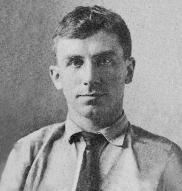
Anton Otto Fischer
(1882-1962)
Anton Otto Fischer was born in Munich, Germany, on February 23, 1882. He was orphaned at an early age and reared in an orphanage. At the age of fifteen he ran away when he was forced to study for the priesthood and became a printer's devil. He soon left this job and ran away to sea.
Fischer was at sea for eight years, except for a fourteen-month period in 1905-06 when he worked for A.B. Frost, a well-known artist, as a model and general handyman. This experience prompted Fischer to take up the study of art seriously, and in October of 1906 he went to Paris to study at the Académie Julian under Jean Paul Laurens. He studied there for two years, spending his summers painting landscapes in Normandy.
Fischer returned to the United States in January 1908 to take up illustration and landscape painting. Attracted by the fame of Howard Pyle, he came to Wilmington from New York City in 1908 and established a studio at 1110 Franklin Street. He freelanced in "subject pictures" paintings telling a human interest story. Subject pictures were very popular in this era and were used for magazine covers as well as full and double spread illustrations.
In 1910, Fischer moved back to New York and received his big break: he was asked to illustrate a story by Jack London in Everybody's Magazine. He continued to illustrate many of London's magazine stories and books until London's death in 1916. By 1912 he was in great demand as an illustrator. From 1909 to 1920 he produced more than one thousand illustrations covering a variety of subjects: pretty girls, women and babies, dogs and horses, the tropics, the far North, the West, city and country life, the Navy, the sports world, and the sea.
Fischer returned to Wilmington briefly in 1932 but soon moved back to New York. With his wife, an artist in her own right, and his daughter, Fischer moved to Woodstock, New York, in 1938, where he continued to produce illustrations but also began working on oil paintings for his book Foc's'le Days. In 1942 he was asked to serve as official war artist by the Coast Guard. Fischer cruised with the United States Coast Guard cutter Campbell in the winter of 1943 and noted much material which he incorporated into his paintings. These paintings were exhibited at the Corcoran Gallery in Washington, D.C., in November 1943.
Fischer continued to do magazine illustrations through the fifties but began to prefer commissions from private individuals for landscapes and marine scenes. On March 26, 1962, he died just before beginning work on a commissioned historical battle painting.
Fischer was extremely prolific in a variety of subjects but is remembered most for his superb marine paintings. He was known for his technical accuracy, strong, tight compositions, and masterful portrayal of men's emotions. Like many illustrators, Fischer used photographs to check positions, lighting, and the way clothes creased, for his illustrations.